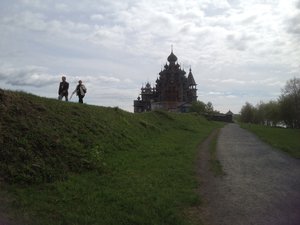Advertisement

 Khizi Island
Khizi Island
Island in the North of Lake Onega - showing the Church of the Transfiguration, built during the reign of Peter The Great.Prior to our arrival PP attended his second Russian language session and returned to the cabin lucid in Russian conversation. Well perhaps not entirely, but his efforts to learn the Cyrillic alphabet before we left and his further boning up since we arrived in Russia meant that he developed a credible skill in interpreting printed material that looked like cooked spaghetti to CS. He became surprisingly adept at reading the words, and because Russian is apparently quite phonetic, ultimately managed to interpret quite a few as well. CS was off the hook trying to decipher street signs, for example, phew!
We arrived at Kizhi at 3pm precisely. The programme so far (and throughout) was followed with military precision and explained at each stage, delightfully and clearly in English and German, by the ever competent and entertaining Kathrin.
The weather continued to be clear, bright and quite wam - a wonderful recipe for the island, which is a small area dotted with aged wooden houses and fields of dandelions. It could be distinctly wind-swept in poor weather. The most notable building is the one that is pictured in all guidebooks, the Transfiguration Church, allegedly built without

 Church of Transfiguration
Church of Transfiguration
No nails used in the construction - pieces of wood notched together instead.nails and featuring 22 timber domes. The whole island is a UNESCO world heritage site and open air architectural museum. We were treated with a bell-ringing from one of the buildings and told that its power results in all viruses being instantly rendered harmless. As CS had recently come down with yet another head cold this was welcome news. Sadly the magic might be somewhat weakened for Australians because most of our group succumbed to the same lurgy in rapid succession over the next days. Ultimately CS found the doctor's prescription for cold and flu tablets rather more effective but the musicality of the bells was not a disappointment.
Sunday, day 9 and we sailed out of Lake Onega (Europe's second largest lake) through the Svir River, heading for Lake Ladoga (Europe's largest lake). On the way we stopped at Mandrogy.
Someone told a cute joke, CS is sorry she cannot remember to whom it is to be accredited. When asked why someone had not purchased a set of matryoshkas, the Russian nesting dolls, the reply was, they are too full of themselves! Boom boom.
Mandrogy purportedly looks like a traditional

 Inside the Church of the Resurrection of Lazarus
Inside the Church of the Resurrection of Lazarus
Built in the late 14th Century - the oldest wooden Church in Russiariverside Russian village, but while Verkhnie Mandrogi ('Upper Falls'😉 was once a small village, it was ruined during WWII and disappeared, until a Russian business-man decided to reconstruct it as a museum featuring local artists and artisans making their genuine works and artefacts and selling direct to the visiting public. The village includes holiday houses, a hotel, a small 'zoo' (housing animals needing veterinarian attention) and a stable for the horses who carry visitors around in their colourful wagons. The range of goods and souvenirs seemed endless and one could be assured they are the real thing when one visits the workshops to see them being made.
CS and PP enjoyed the stroll in the perfect weather around the island, including taking a short punt ride across to the zoo. Not being ones for souvenirs we did not purchase any matryoshkas, but the size, variety and quantity on display was overwhelming. Jewellery and woven goods, wood carvings and beautiful birch tree ornaments were also available in profusion. It would seem the entrepreneurial flair of its founder has borne fruit. On our rounds we happened to notice Kathrin, apparently a keen horsewoman, taking time out to have a
ride. Unfortunately unlike her own steed this old boy was not to be persuaded to move at much faster than a walk. His girth might explain his reluctance - horses do not go hungry on Mandrogy.
We left Mandrogy at 1.30pm anticipating our next arrival on the morrow in fabled St Petersburgh. The evening meal was the Captain's opportunity to bid us farewell as we would be sailing no further despite remaining on the vessel for some days more. Our group had become well used to attending the Sky Bar in the evenings to hear Marisa and Edgar play dance music for us. Tonight was no exception. One of our number, Anne H has a lovely talent for encouraging others to participate and get onto the dance floor. We are not sure how some of the sterner German guests coped with the antics of the Australians but on the whole our collective joie de vivre seemed to be well received.
Advertisement
Tot: 0.073s; Tpl: 0.011s; cc: 12; qc: 56; dbt: 0.0352s; 1; m:domysql w:travelblog (10.17.0.13); sld: 1;
; mem: 1.2mb

 Khizi Island
Khizi Island
 Church of Transfiguration
Church of Transfiguration
 Inside the Church of the Resurrection of Lazarus
Inside the Church of the Resurrection of Lazarus






